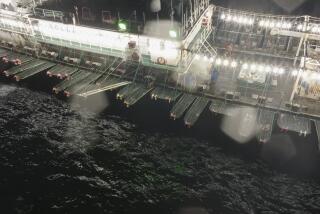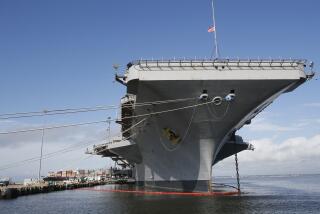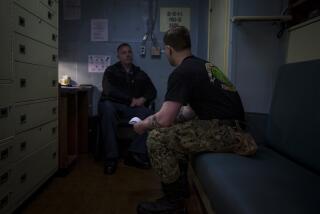Avoiding Seasickness Can Be a Balancing Act
- Share via
Some sailors have a lifelong history of seasickness. It is said that the English admiral Horatio Nelson, victor of the naval battle against Napoleon’s fleet at Trafalgar, was violently ill every time his ship left port. After three days at sea, however, the nausea, vomiting and feeling of despair--all typical of seasickness--subsided and he was back on deck enjoying the rigors of command.
Most people are more fortunate than Nelson. They are blessed with a balance mechanism in the middle ear that is able to quickly adjust to at least moderate movement and so can avoid unpleasant symptoms as the ship plows through the bounding main.
There is no sure way to predict whether a first-time sea voyager will be able to handle a ship’s motions without ill effects. But getting car or airsick, especially as an adult, is a good indicator of what will happen on a boat.
“If you can ride a Ferris wheel or a merry-go-round without feeling sick, you will probably be OK on a ship,” said Dr. Julia Gulya, a Georgetown University specialist in illnesses that affect equilibrium.
The tendency to be seasick, incidentally, almost never means there is something medically wrong. It just means the inner-ear balance mechanism is especially sensitive to motion.
But most sensitive sea travelers are not willing to put up with the queasiness for several days until their equilibrium has a chance to adjust. Fortunately for today’s sailors, there are both drug and non-drug ways to prevent or ease the misery of seasickness.
Some of the non-drug methods, such as warm tea, are folk remedies that have not been proven by science. Others, such as keeping one’s eyes focused on the horizon and not making any sudden or rapid head movements, seem to have a good physiological basis for working.
This is supposed to minimize stimulation of the inner ear and other sensors involved in dealing with gravity and determining the body’s orientation. These sensors and the finely tuned balance mechanism can become overstimulated by the ship’s movement. The result is that sensors in different parts of the body, including the eyes, send mixed messages to the brain. If the brain is unable to unscramble these messages, nausea and vomiting are a consequence.
Two important factors influence the motion of a boat in anything but a calm sea. One is the size and shape of the vessel. Another is the direction of the vessel combined with the movement of the waves. Short, narrow ships, which roll more, tend to be more troublesome than long, wide vessels. Of the three main ship movements--roll (side to side movement), pitch (up and down movement) and yaw (sort of a fishtailing movement)--rolling is most apt to cause seasickness, according to U.S. Navy Capt. Robert Hain of the Navy’s Bureau of Medicine.
One way cruise lines have attempted to minimize potential discomfort is by designing ships with stabilizers, which generally are retractable fins that run lengthwise on the bottom of the hull. The fins are designed to minimize the rolling motion by increasing the ship’s resistence to wave movement. But do they work?
“Most commercial cruise liners have stabilizers, which tend to ease the ship. But in heavy seas,” nothing works very well, Hain said.
People who prefer not to take drugs may be able to ease these symptoms and prevent vomiting by drinking ginger ale, 7-Up or other lemon-flavored drinks. Some say the drink should be iced; others swear by warm drinks, including tea. Others insist on taking ginger in the form of a pill that can be purchased in natural food stores. Eating soda crackers or dry toast and avoiding greasy or highly spiced foods can help, too.
Going to sea with a hangover, sleep-deprived or emotionally upset will increase the chance of succumbing to seasickness. It is helpful to stay on deck as much as possible--eyes on the horizon and face into the wind--keeping upwind from any noxious odors such as engine exhaust. When below deck, try to stay as close as possible to the ship’s center, where movement is the least obvious.
For some people, adjusting to ship movement takes longer than the usual three or four days. In rare instances, adjustment never occurs. In the Navy that’s cause for discharge from the service. For civilians, it probably means that future vacations should be planned for land, assuming the seasickness cannot be treated by one of the two types of medication that are usually successful.
The best-known drug is Dramamine. It, like Bonine and Marezine, is a nonprescription antihistamine that should be taken one hour before leaving the dock. Effectiveness may be minimal if taken after symptoms occur. One drawback is that these drugs cause drowsiness. Other antihistamines new to the market do not have that effect but do not prevent seasickness. It is the sleep-inducing component of the antihistamines that prevents nausea.
The second type of medication is Transderm Scop, a stick-on patch containing the prescription drug scopolamine that is worn behind the ear. The patch slowly passes the drug through the skin and into the bloodstream, where it reaches the inner ear and reduces the stimulation. Many doctors recommend that it not be given to children. Tranquilizers and antidepressant drugs, in either pill or suppository form, are sometimes prescribed by physicians for people with special susceptibility to seasickness.
The Navy, Hain said, does not spend much time dispensing medications to seasick-prone sailors. Most sailors become accustomed to the rocking and rolling, he said. An exception might be in very heavy seas when even the most seasoned sailor can be found hanging over the rail.
One of the most novel seasick preventives, and one that is scientifically controversial, was invented about 10 years ago by Hank Jonas, a West Palm Beach, Fla., yachtsman. Called Travel Garde, it consists of two knitted bands fitted with a pea-shaped bead that presses on the acupressure point on the wrist that is said to control nausea.
Physicians contacted for this column scoff at the suggestion that the wrist bands actually work. But one British study indicated success with the bands in easing morning sickness in pregnant women. However, another scientific study, by British Navy researchers, found that the bands failed to quell nausea in a laboratory experiment. The researchers said the failure may have been due to the fact that subjects did not move their wrists enough to provide continuous stimulation to the acupressure point.
More to Read
Sign up for The Wild
We’ll help you find the best places to hike, bike and run, as well as the perfect silent spots for meditation and yoga.
You may occasionally receive promotional content from the Los Angeles Times.






